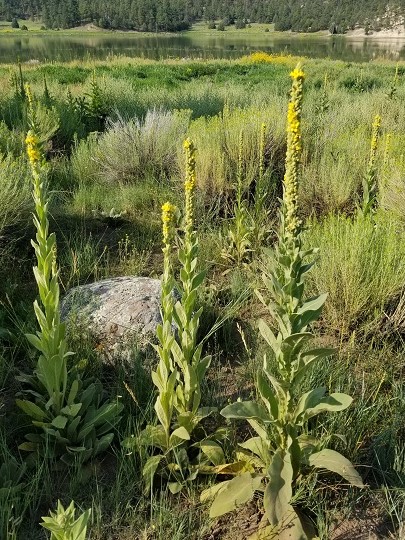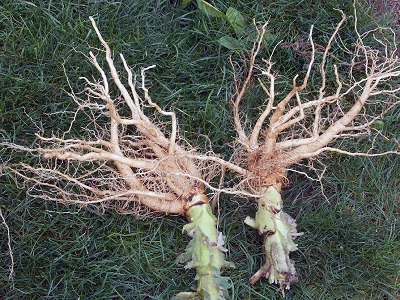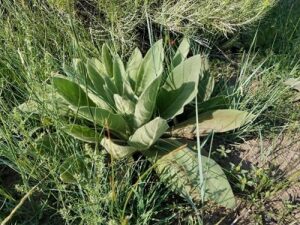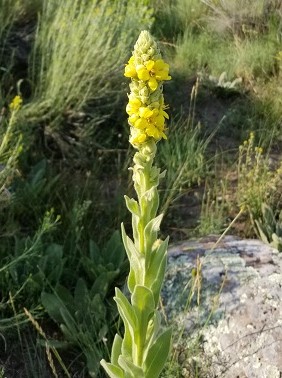Common Mullein (Verbascum Thapsus)
Family –Scrophulariaceae or the figwort family
Table of Contents
My friendly Mullein Rant
Common Mullein is one of the top 10 most wanted in the government’s war against noxious weeds. A native of the Mediterranean, it was first brought to the US as an ornamental and medicine plant. Then, in a relatively short time, Mullein naturalized. As a result, it can now be found growing just about everywhere. In some places large stands of Mullein are found in a monoculture (with nothing else growing). At first glance they appear to be taking over. Let’s take a closer look.
Mullein thrives in damaged soil. An overgrowth of Common Mullein is typically found in the wake of a forest fire, near burned brush piles, in the debris of rockslides and anywhere the soil is open, exposed, and damaged. Once established, it seems to take over for a few years. Nevertheless, as the soil recovers and native growth returns, Mullein begins to recede. This natural process is said to run in about 7-year cycles. One theory is that a severe insect infestation causes Mulleins decline.
The moral of the story is that Nature Is Intelligent and knows what it needs and when. The human ego does not understand or is incapable of seeing the big picture.

The Earth (every part of it) is alive and intelligent. Humans in general and County and State governments in particular, see through a narrow lens, one that reflects their own ideals of perfection onto nature. Often, I would even say most times, human vision of what nature should look like does not allow for time or for higher forms of inspirational intelligence. As a result, the war with nature resumes with Common Mullein at the forefront.
I love this plant. It’s one of my favorites. (Do I say that about every plant? Maybe.) Anyway, every part of the Mullein plant is useful and makes wonderful medicine. The plant is a biennial, meaning it has a 2-year life cycle.
The Many Names of Mullein
Common Mullein is also called Great Mullein, Woolly Mullein and Flannel Mullein. The Romans called it Jupiter’s staff. Other names for this plant through the ages include beggar’s blanket, velvet plant, felt-wort, tinder plant, candlewick plant, witch’s candle, donkey’s ears, hag’s taper, candlewick plant, torches, and Quaker rouge. I’m sure there are more, but we’ll stop there.
Healing Properties
Demulcent, expectorant, emollient, astringent, anti-inflammatory, antibacterial, and antiviral. The whole plant possesses slightly sedative or narcotic properties. The root is warming, astringent and bitter; the leaves and flowers are cooling, astringent and bitter.
Medicinal Uses of Common Mullein
Every part of this handy plant is used medicinally, each part in its own way. One can think of Mullein’s use as a mirror to the human body. The roots are most often used for issues below the waist and for what grounds us. The leaves for the middle part or trunk of the body and the flowers for the head.
Mullein Root
The root of the Common Mullein plant is harvested at the end of its first year or the beginning of the second growing season, before flower spikes begin to elongate, as this is when the white taproot is most juicy. When harvesting the root, or any part of the plant, separate all plant parts in the field. For example, remove the root from the leaves. If the leaves are beautiful, they can be used as described below otherwise discard them. For some reason, medicine made from all parts of Mullein are best when separated in the field.
Medicinal Use of Mullein Root
Mullein root is helpful when dealing with many problems below the waist. It is astringent and diuretic, removing excess and balancing fluid levels, while toning the urinary tract. Use Mullein root for bladder inflammation, UTI, painful diarrhea, urinary incontinence, inflammation in the joints (like arthritis) and internal bleeding. The root of the mullein plant helps to tighten and tone the pelvic floor in women. Thus, making in useful in formula, for treating and preventing prolapses of the abdominal region. (See Abdominal Organ Prolapse for more information.) For men, the root of the Common Mullein helps reduce prostate swelling and inflammation. Used, again in formula, helps diminish nocturia (nighttime urination), urinary dribbling and pelvic fullness syndrome caused by BPH. For children, mullein is often used to prevent and treat urinary incontinence and nighttime bed wetting. (it works for adult too.)

The root is used (with other herbs) to address chronic pain especially the kind of pain related to old injuries, joint problems, and arthritis, and it is indicated for the bone-deep kind pain that sometimes accompanies hard swellings. Mathew Woods says small doses of the root tincture (about 7 drops), or the root infusion, helps restructure structural misalignments of broken bones. Mullein root has a moistening and lubricating effect of the synovial membranes and is hydrating to the spine and joints. As a result, it suggested when working with repetitive strain injuries, pain in the small bones of the hands or feet, and pain associated with slipped vertebrae and more.
Many Herbalists use Mullein root to treat Bell’s Palsy with great success.
For more information about how to use Common Mullein root to work with specific conditions please read the following Ask Annie Blog Posts
Common Mullein Leaves
The Leaves are harvested when they are most beautiful usually near the end of the first or beginning of the second year, before the flower stalk emerges. Remember to separate the leaves from the rest of the plant before your hike home. Then, loosely dry the leaves until crisp or easy to break apart. I like to thinly spread them in a large box and stir 3 to 4 times per day until dry. When making the tincture, I prefer a fresh plant extract with 1-part clean fresh leaves to 2 parts 40 percent alcohol.
Medicinal Use of Mullein Leaves
Use Common Mullein leaf to help relieve any kind of respiratory distress, especially chronic dry or spasmodic coughs and asthma, acting as a relaxing, moistening, expectorant for upper respiratory issues. The leaves are equally effective for both short-term, acute infections and chronic or long-standing issues. Additionally, Mullein leaves are useful for respiratory conditions that seem to come and go or are on the verge of becoming chronic.

This herb is valuable in the treatment and prevention of COVID19. It is soothing and expectorant and can be used throughout the entire course of the illness from exposure through recovery. Mullein leaf tea or extract is employed to protect respiratory cilia and prevent the build-up of fluids and stagnation COVID can cause. (For more about COVID19 and the use of Mullein please visit “COVID19 an Herbal Perspective”)
Externally, the leaves of the Common Mullein are used in wound healing. Likewise, they are applied externally and in salves, infused oils, ointments and poultices to protect, moisten and heal the skin.
Mullein leaves are a mild remedy that can be used alone or combined with other herbs. The leaves may also be burned like incense. The distributed smoke is then inhaled providing almost immediate relief of acute episodes of respiratory constriction and spasms.
To learn more about how to apply Mullein leaves in specific situations read the following Ask Annie Blogs
Mullein Flowers
I Love me some Mullein flowers. Whenever I harvest these tiny little flowers, it always reminds me of Michael More (the herbalist). He used to say that collecting the Mullein flowers was akin to botanical yoga. So true! Each small, inset flower is removed from a kind of elongated “stalked or corn” one at a time. Though I’ll admit, I do not take the time separate the flowers from their corns in the field. Rather, I prefer to bring the whole flower top home where I can work on them in relative comfort.
The flowers are not difficult to remove, only a tad tedious. I do not mind. The flowers are removed from the stalk and placed in a bowel where they are left to wilt for a day, sometimes two. Once wilted they are processed further, depending upon what I’m making that day.
Medicinal uses of Mullein Flowers
The flowers are highly antiseptic and anti-viral. They are also slightly sedative or relaxing. With the smell, or even being in the same room invoking a sense of calmness and peaceful well-being. Though, not all people feel it in the same way and some more than others. The flowers are particularly indicated when severe or chronic pain is causing a sense of darkness, depression, or hopelessness. A few drops might be all that’s necessary in a formula to get a good energetic effect.
Common Mullein flowers can be used both internally and externally. Internally the tincture is used to treat swellings and helps relieve some of the pain of inflammation. Also, internally, the flowers are effective as a bronchodilator for asthmatic conditions. This is especially so when combined with leaves of the same plant. Additionally, Mullein flowers work well with other herbal anti-infectives to clear toxic heat and/or infection. For this purpose, they mix well with herbs like goldenseal, Algerita, Oregon grape, Plantain, Pau d’arco, and Echinacea.

Externally, an infused oil (or tincture) of Common Mullein flowers is one of the most popular remedies for treating an ear infection and rightly so. A few drops of warmed Mullein flower in the ear will help ease the pain of an ear infection and speed recovery time. I like to combine the flowers with garlic for both the infused oil and tincture ear formulas. Garlic is also a strong antibacterial and antiviral. There are few remedies as effective and reliable for treating ear infections. Alone or in combination, the oil is also used to address problems associated with the accumulation of ear wax. Mullein flower infused oil is a favorite for treating ear mites in animals. Plus, it has an old reputation for restoring hearing, though this claim probably stems from its ability to remove accumulations of ear wax.
And finally, I have found Mullein flowers to be an effective and reliable treatment for all strains of the herpes virus. The flowers infused in olive oil are also a very effective treatment for all known strains of herpes simplex virus. For this purpose, it can be used both internally and externally. However, I have found it effective when applied externally in whatever form is handy.
An infusion of Mullein flowers makes a soothing and nourishing eyewash.
Common Mullein Recipes
Mullein Flower Ear Oil
- ¼ cup wilted Mullein flowers
- 1 clove of garlic crushed
- Olive oil or vodka
Place Mullein flowers and crushed garlic in a small jar. Cover with olive oil. Set in a sunny window and shake 1 to 4 times per day for 2 weeks.
Strain out herbs.
To use, warm oil and place 1 or 2 drops in the ear or behind the ear. If there is fluid or mucus coming from the ear, use vodka rather than oil.
Breathe Easy Herbal Extract
Use equal parts of the following individually prepared herbal extracts
- Mullein leaf
- Usnea
- Grindelia
- Monarda stricta
- White Horehound
- Blue Vervain
Take 1 or 2 dropper fills, 3 to 4 times per day for relief from chronic or acute bronchial issues
Mullein Tea
- Simmer 1 tablespoon dry Mullein Leaf herb in 2 cups lightly boiling water for about 5 minutes. Strain and drink hot.
COVID Respiratory Support Tea
For Use as a preventative measure or before the tipping point (when symptoms are still mild)
- 1-part ground Black Cumin seeds
- 1-part Mullein Leaf and/or flowers
- 1-part Fennel seeds
- Simmer 1 tablespoon of combined herbs in 2 cups lightly boing water for about 5 minutes. Strain and drink hot. Honey may be added to taste.
Contra-Indications
The plant is nontoxic. However, the wooly hairs on the leaves can be irritating to the skin causing dermatitis or a rash in a sensitive individual. The leaves and flowers may irritate the mucus membranes in the throat, causing irritation. When preparing a tea of the leaves, consider straining the leaf and flower tea through a fine filter before drinking. Boiling the leaf and flowers for a moment or two usually renders the little hairs harmless.

Common Mullein Products Available at Wonderment Gardens
References
https://botanical.com/botanical/mgmh/m/mulgre63.html
Sinadinos, Christa, Clinical herbalist; Medicinal Uses of Mullein Root, Medical Herbalism A Journal for the Clinical Practitioner, (2009) Volume 16, Number 2. p. 1-15
Disclaimer
The statements and ideas presented here are not intended to diagnose, treat, cure, or prevent any disease or condition. They have not been evaluated by the FDA. All ideas presented are for the sole purpose of education. To help you take control of your own health. If you have a health concern or condition, consult a physician. We suggest that you always consult a medical doctor before modifying your diet, using any new product, drug, supplement, or doing any new exercises.
These statements and products have not been evaluated by the FDA. They are not intended to diagnose, treat, cure, or prevent any disease or condition. If you have a health concern or condition, consult a physician. Always consult a medical doctor before modifying your diet, using any new product, drug, supplement, or doing any new exercises.
Herbs taken for health purposes should be treated with the same care as medicine. Herbal remedies are no substitute for a healthy diet and lifestyle. If you are serious about good health, you’ll want to combine diet, exercise, herbals, a good relationship with your doctor and a generally healthy lifestyle. No one of these will do it alone.
This information is designed to be used as part of a complete health plan. No products are intended to replace your doctor’s care, or to supersede any of his/her advice or prescriptions.


Pingback: An Herb Walk in the Woods - Wonderment Gardens
Very good post! We are linking to this particularly great article on our site.
Keep up the good writing.
Greetings! Very helpful advice within this post! It’s the little changes that will make the
most significant changes. Many thanks for sharing!